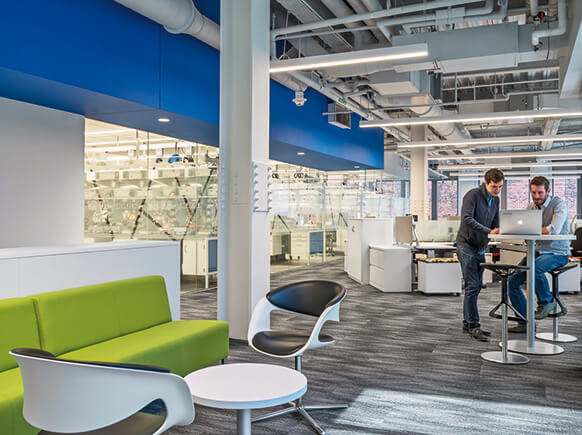March 2024 update: We recently returned to the ingredients of our “secret sauce” and found them to be as true today, in 2024, as they were when originally drafted in 2017.
As designers, we are seeing firsthand the extraordinary and lightning-quick changes in the education world. Related forces are also affecting spaces for research and innovation.
At a symposium held by the Association for Learning Environments, the other speakers and I explored how education design enables the next generation of students to tackle our society’s most compelling issues after they’ve entered the workforce. The “how” of designing schools – or any next-generation environment – gains new definition when we consider the project’s wider context. To expand my vision, I like to use a perspective that comes from journalism: the “Who, What, Where, When, How and Why” of any narrative.
In order to figure out how to design these future environments, we must start by exploring why we design them. Society’s challenges and opportunities demand an evolved sensitivity to their solutions. If we don’t empower the next generation to enter the workforce with foresight and creativity, those students simply won’t keep up.
Also, who are we designing for? This next generation is sometimes called Generation A – or as Ibrahim Ibrahim of our partner firm Portland Design has it, Generation C. They demand control, they have the power to choose like never before, they love to customize what’s in front of them, and they insist on collaborating. These students are tough customers yet they’re totally invigorating to a designer: They scrutinize everything, they demand integrity and openness, they want entertainment and play in work, education, and leisure.
What kind of spaces are we designing anyway? To be honest, we don’t currently know. Sixty-five percent of children entering primary school today will end up working in job types that don’t even exist yet! I’m awed by imagining the kind of learning environments that can anticipate these future workspaces. Take, for instance, the pending revolution in quantum computing, which may solve problems that would currently take the lifespan of the universe to solve. There’s also the convergence of mechanical engineering and biology, which is creating new hybrid materials, and the fact that researchers can use Big Data to reverse the traditional cycle of biotech research, generating discoveries not from the bench but from real people. Simply put, today’s science is outpacing the ability of traditional labs to support it.
Where will these as yet unknown environments for discovery be located? Well, everywhere! Once again, because we cannot design without understanding who we’re designing for, this next generation will make discoveries and create inventions everywhere. The so-called Digital Nomads don’t just go where the innovative jobs are. They’re redefining how they relate to time, geography, coworkers, consumption, education, employment and recreation.
When do we design spaces supporting innovation? Obviously the answer is now. Access to information now comes at unprecedented speed and convenience. Smartphones alone, in just the last ten years, have revolutionized our expectations surrounding time, innovation, and the constant stream of new ideas and applications.
So, armed with all those, how do we actually design spaces for the next generation of innovation? I tend to stress twelve ideas – you might also call them the ingredients of our “secret sauce.”
1 – Translate functional processes and adjacencies into building-wide social networks.
As planners and designers, we are accustomed to diagramming functional requirements into chunks that allow us to size and locate programmatic elements into a design. Tossing away such thinking helps us consider a higher order, by looking at the social networks connecting people to functional requirements.
2 – Let spaces adapt to needs, not the other way around.
3 – Create meaningful separations.
Today’s workplaces focus so intently on openness and collaboration that we forget how separations can be beneficial, especially when required for safety or environmental controls. The critical task is to understand how separations connect people as much as open space does.
4 – Provide a flexible and robust infrastructure.
We cannot predict future tools but the power, data, gasses, and utilities required to operate those tools can be reasonably anticipated.
5 – Allow buildings and spaces to be engines of discovery.
6 – Mix together programs, technologies, people, spaces, and functions.
As disciplines converge – chemistry, biology, engineering, mathematics and so many more – allow those activities and people to converge. Think three-dimensionally where possible.
7 – Celebrate movement, food, coffee, air and daylight.
Comforts like these keep people happy, healthy, and productive, which are themselves essential elements in encouraging and supporting collaboration and integration.
8 – Embrace mess and don’t hide the fun stuff.
9 – Force transparency.
There’s a reason people love going to the aquarium. It’s lovely to watch things happening. We have nothing to hide–and everything to gain–from physical transparencies, which allude to emotional, corporate and scientific transparency. Despite the reference to aquariums, we seldom hear concerns anymore about the ‘fishbowl’ effect. Perhaps that’s because glass walls are now so ubiquitous–or perhaps it’s because so many of us live within the virtual glass walls of social media.
10 – Don’t fear noise. Plan for it!
Design to enhance well-being and community as much as the operations of technology and equipment.
11 – Offer choice.
Our environments impact our creativity not just in configuration and characteristics, but also in their diversity. Sometimes a change of perspective – literally and figuratively – unlocks discovery.
12 – Finally, create community.
Going back to our very first principle, about building-wide social networks: Design must revolve around the user. Discovery can happen on its own, but in a community it really thrives.

